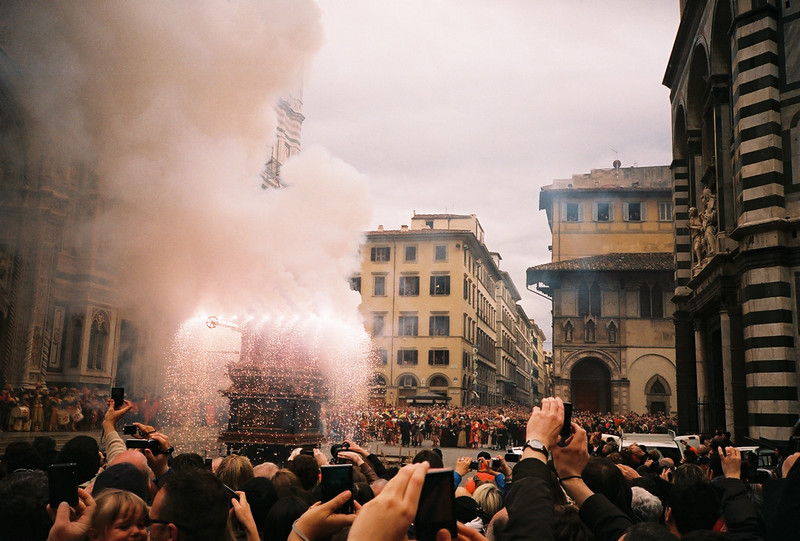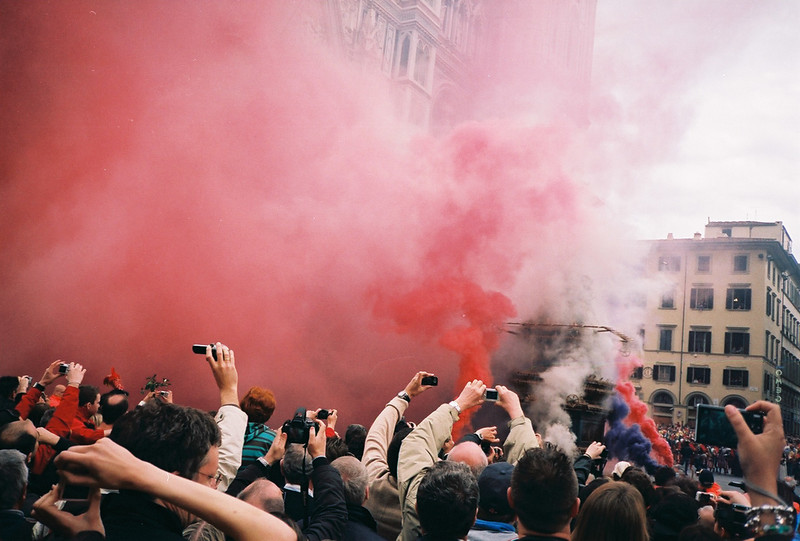Scoppio del Carro
Florence's Explosive Easter Spectacle
2026/04/04
Every Easter Sunday, Florence's Piazza del Duomo comes alive with the unique celebration of "Scoppio del Carro". At 10 AM, a 9-meter-tall ancient cart, pulled by white oxen adorned with flowers, slowly makes its way from Porta al Prato to the square. The cart is accompanied by 150 soldiers, musicians, and citizens dressed in 15th-century costumes, with the sound of drums and the spectacular performances of flag-wavers coloring the city. At 11 AM, as the Easter Mass reaches its climax and the bells of Giotto's bell tower ring out, a mechanical dove is launched from the cathedral's altar, colliding with the cart. This triggers a grand 20-minute fireworks display, eliciting cheers from over 40,000 spectators. This tradition, continuing for over 350 years, is a unique festival that blends religion and folk beliefs, praying for Florence's bountiful harvest and prosperity.
Main Attractions
Brindellone: The Exploding Cart
At the heart of Scoppio del Carro is the Brindellone, a 9-meter-tall ancient cart that has been in use for over 500 years. At dawn, this ornate wooden tower, adorned with garlands of spring flowers and herbs, begins its journey from Porta al Prato to Piazza del Duomo. As the white-coated oxen, gleaming in the morning sun, slowly pull the cart through Florence's narrow streets, the air fills with the earthy scent of hay and the sweet fragrance of flowers.
Accompanying the Brindellone is a procession of 150 musicians, soldiers, and citizens dressed in vibrant 15th-century costumes. The sound of drums and trumpets echoes off ancient stone walls, while the swish of silk and velvet costumes adds to the sensory tapestry. This colorful parade offers a glimpse into Florence's rich Renaissance history, with each participant embodying a piece of the city's past.
Colombina: The Dove's Fiery Flight
As the cart reaches Piazza del Duomo, all eyes turn to the cathedral. Inside, amidst the scent of incense and the glow of candlelight, the Archbishop of Florence prepares to ignite the festival's most crucial element: the Colombina. This mechanical dove, symbolizing the Holy Spirit, sits perched on a wire stretching from the high altar to the cart outside.
At the crescendo of the Gloria during Easter Mass, the Archbishop uses the holy fire, lit from ancient flints brought back from the First Crusade, to ignite the Colombina. With a whoosh, the dove races along the wire, leaving a trail of sparks in its wake. The crowd holds its breath as it nears the cart, knowing that a successful ignition promises a bountiful year ahead.
The Explosion: A Symphony of Fire
The moment the Colombina reaches the Brindellone, the square erupts in a cacophony of light and sound. Fireworks burst forth in a carefully choreographed display, painting the sky with cascades of gold, red, and green. The acrid smell of gunpowder mingles with the sweet scent of roasting chestnuts from nearby vendors, creating a unique olfactory experience.
For 20 minutes, Piazza del Duomo becomes a theater of fire and smoke, with each explosion eliciting gasps and cheers from the assembled crowd. The vibrations from the fireworks can be felt through the cobblestones, connecting spectators to the raw energy of the event.
Easter Feasting: A Taste of Tradition
As the smoke clears and the excitement settles, Florence's cafes and restaurants buzz with activity. Traditional Easter dishes take center stage, with the aroma of roasted lamb and fresh-baked colomba (dove-shaped Easter cake) wafting through the air. Local specialties like crostini di fegatini (chicken liver pâté on toasted bread) and pappa al pomodoro (bread and tomato soup) offer a taste of Tuscan cuisine.
In the streets, vendors sell traditional Easter treats like schiacciata alla fiorentina, a soft, orange-flavored cake dusted with powdered sugar. The day's celebrations often conclude with families and friends gathering for long, leisurely meals, toasting to good fortune with glasses of local Chianti wine.
Cultural and Historical Background
Scoppio del Carro is a traditional event with over 500 years of history, blending Florence's religious fervor and artistic creativity. Its origins date back to the First Crusade in 1097. According to legend, Pazzino de' Pazzi, a Florentine nobleman, distinguished himself in the conquest of Jerusalem and was rewarded with three flints from the Holy Sepulchre. These flints are still carefully preserved in Florence's Church of Santi Apostoli and serve as the source of the "holy fire" used in the annual festival.
Initially, the ceremony was a simple ritual where young men carried torches lit by the holy fire throughout the city. Over time, it evolved into the grand spectacle we see today. In the late 15th century, the massive cart now known as the Brindellone was introduced. This 9-meter tower is meticulously decorated by citizens each year, symbolizing Florence's prosperity and technological prowess. In the early 16th century, at the suggestion of Pope Leo X from the Medici family, the Colombina (mechanical dove) was added. This represents both the Holy Spirit and embodies Florence's innovative spirit.
Scoppio del Carro holds deep cultural significance for the people of Florence. The cart, bearing the Pazzi family coat of arms, symbolizes civic pride and historical identity. Moreover, this festival is a unique cultural phenomenon that fuses religion with folk beliefs. The successful flight of the Colombina and the subsequent fireworks are seen as omens for a good harvest and prosperity, particularly important for the surrounding rural communities. Furthermore, the 150 procession participants in 15th-century costumes and the spectacular flag-waving performances embody the continuation of Florence's Renaissance culture. This festival is a living cultural heritage that the people of Florence cherish, connecting their past, present, and future.
Participants Voices
As an American tourist, I happened to be in Florence during Easter and unexpectedly encountered the Scoppio del Carro. The atmosphere in Piazza del Duomo was electric, as if the air itself was vibrating with excitement. An elderly local couple standing next to me must have noticed my confused expression. They kindly explained the meaning of each part of the ceremony to me, as if they were telling a story to their grandchild. They shared memories of past festivals and how the event has changed over the years. By the time the dove-shaped rocket was launched, I felt like I was no longer just a tourist, but a part of this special event. The fireworks explosion was incredible, of course, but what left an even deeper impression was the bond between the people of this city and the weight of tradition that has been passed down through generations. It's sure to be an unforgettable experience that will stay with me for life.
Fun Facts
- The Brindellone cart is over 500 years old and stands 9 meters tall. It's so large that it has its own garage on Via il Prato where it's stored for the rest of the year.
- The three flints from Jerusalem used to light the holy fire are still preserved in the Church of Santi Apostoli in Florence.
- If the Colombina fails to ignite the cart or returns to the altar unsuccessfully, it's considered a bad omen for the year ahead.
- The oxen that pull the cart are specially bred for the event and are adorned with flowers and herbs gathered from the Tuscan countryside.
- In 1097, when Pazzino de' Pazzi brought back three flints from Jerusalem, the tradition began with young men carrying torches lit by the "holy fire" throughout the city.
Festival Dates
The Scoppio del Carro takes place every Easter Sunday in Florence, Italy.
The event schedule is subject to change. Please check the official website for the most up-to-date information.
Information
| Name | Scoppio del Carro |
| Country | Italy |
| Area | Florence |
| Date | 2026/04/04 |
| Link |
Upcoming Festivals
Whirling Dervishes Festival Turkey
A Mesmerizing Dance of Divine Love
2025/12/06Mevlana Celaleddin Rumi Commemoration Ceremony ( Şeb-i Arus ) Turkey
A Whirling Journey to Divine Love
2025/12/10Dia de la Virgen de Guadalupe Mexico
A Festival Weaving Faith, Fervor, and Mexican Identity
2025/12/11L'Escalade Switzerland
Geneva’s Grand Winter Festival of Courage, Chocolate, and Community
2025/12/12Umkhosi Wokweshwama South Africa
The Zulu First Fruits Festival—A Sacred Celebration of Land, Ancestors, and Renewal
2025/12/12Lucia Festival (St. Lucia's Day) Sweden
A Festival of Light Illuminating the Nordic Darkness
2025/12/15Las Posadas Mexico
The Luminous Quest for Sacred Shelter
2025/12/22Noche de Rabanos (Night of the Radishes) Mexico
A celebration blending art, farming heritage, and cultural traditions
2025/12/23Chant of the Sybil on Majorca Spain
A Medieval Prophecy Echoes Through Majorcan Christmas
2025/12/23‘Hatajo de Negritos’ and the ‘Hatajo de Pallitas’ Peru
A Christmas Festival of Rhythm, Faith, and Afro-Andean Heritage in Peru’s Ica Region

